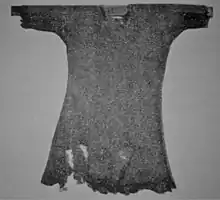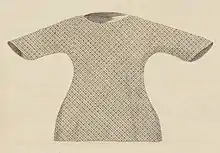Baju Rantai
The Baju Rantai (also known as Badjoe-Rante, Baju Besi, Baju Rante, Wadjoe-Rante, and Waju Rante) is a type of armor from Nusantara archipelago (Indonesia, Malaysia, Brunei, and Philippines).

Etymology
The name originates from old Javanese words, baju comes from waju meaning clothing or apparel, meanwhile rantai comes from rante or ranti which mean chain.[1]
Description
The Baju Rantai is a chain armor that is worked in the form of a shirt. It consists of small iron rings. It has no collar and sleeves that reach about to the elbow. The lower end is approximately at the height of the thighs. It is used by various ethnic groups in Indonesia.[2]
History


One of the earliest mention of Baju Rantai is in Kidung Ranggalawe, a javanese kidung text that tells about the rebellion of Ranggalawe against Majapahit in 1295 A.D.. The name in the text is waju rante, which means apparel consisting of iron chains. Zoetmulder noted the use of special apparel for soldiers: In his research about old Javanese he found a troops called bala winaju gangsa ranti,[3]:1370 which means soldier dressed with gangsa ranti. Gangsa (from sanskrit: kangśa) refers to a kind of copper and lead alloy,[3]:275 while ranti means chain.[3]:919
The Chronicle of Banjar noted the Bhayangkara equipments in the Majapahit palace, which includes :
... dengan perhiasannya orang berbaju rantai empat puluh serta pedangnya berkopiah taranggos sachlat merah, orang membawa astengger empat puluh, orang membawa perisai serta pedangnya empat puluh, orang membawa dadap serta sodoknya sepuluh, orang membawa panah serta anaknya sepuluh, yang membawa tombak rampukan bersulam emas empat puluh, yang membawa tameng Bali bertulis air empat puluh.
... with their jewelry men with chain mail numbered forty alongside their swords and red kopiah [skull cap], men carrying astengger [arquebus] numbered forty, men carrying shield and swords numbered forty, men carrying dadap [rattan shield] and sodok [broad-bladed spear-like weapon] numbered ten, (men) carrying bows and arrows numbered ten, (men) who carried spears embroidered with gold numbered forty, (men) who carried Balinese shields with water engraving numbered forty.
— Hikayat Banjar. 6.3
Two related ethnic communities of South Sulawesi, the Bugis and Makassarese, also adopted chain mail armor which they call as waju rante or waju ronte. The armor is made by string of iron rings tied together, which makes it similar to knitwork.[4]:39 During years of warfare, Bugis and Makassarese soldiers, dressed in chain mail and carrying muskets which they made themselves, acquired formidable reputation for ferocity and courage.[5]:209
See also
References
- Zoetmulder, P. J. (1982). Old Javanese-English dictionary. The Hague: Martinus Nijhoff. ISBN 9024761786.
- Albert G. van Zonneveld: Traditional weapons of the Indonesian archipelago. C. Zwartenkot Art Books, Leiden 2001, ISBN 90-5450-004-2, S. 28.
- Zoetmulder, P. J. (1995). Kamus Jawa Kuno – Indonesia. Jakarta: PT. Gramedia Pustaka Utama.
- Hamid, Pananrangi (1990). Senjata Tradisional Daerah Sulawesi Selatan. Direktorat Jenderal Kebudayaan.
- Marsden, William (1966). A History of Sumatra. Kuala Lumpur.
Further reading
- William G. Shellabear: An English–Malay Dictionary. Methodist Publishing House, Singapore 1916, (Digitalisat).


